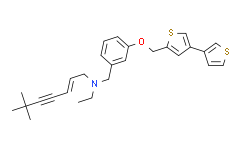| Cas No.: | 131060-14-5 |
| Chemical Name: | NB-598 free base |
| Synonyms: | Benzenemethanamine,3-([3,3'-bithiophen]-5-ylmethoxy)-N-[(2E)-6,6-dimethyl-2-hepten-4-yn-1-yl]-N-ethyl-;(E)-N-ethyl-6,6-dimethyl-N-[[3-[(4-thiophen-3-ylthiophen-2-yl)methoxy]phenyl]methyl]hept-2-en-4-yn-1-amine;Benzenemethanamine,3-([3,3'-bithiophen]-5-ylmethoxy)-N-[(2E)-6,6-dimethyl-2-hepten-4-yn-1-yl]-...;NB-598;(E)-N-(6,6-dimethyl-2-hepten-4-ynyl)-N-ethyl-3-[4-(3-thienyl)-2-thienylmethyloxy]benzylamine;(E)-N-(6,6-dimethyl-2-hepten-4-ynyl)-N-ethyl-3-[4-(thien-3-yl)-thien-2-ylmethyloxy]benzylamine;(E)-N-ethyl-N-(6,6-dimethyl-2-hepten-4-ynyl)-3-[(3,3'-bithiophen-5-yl)methoxy]benzenemethanamine;AC1O5YMV;CHEBI:136374;CHEMBL27885;DCL000019;Dermolastin;DNC000998;NB598 |
| SMILES: | S1C(COC2=CC=CC(CN(C/C=C/C#CC(C)(C)C)CC)=C2)=CC(C2C=CSC=2)=C1 |
| Formula: | C27H31NOs2 |
| M.Wt: | 449.671 |
| Purity: | >98% |
| Sotrage: | 2 years -20°C Powder, 2 weeks 4°C in DMSO, 6 months -80°C in DMSO |
| Description: | NB-598 is a potent and competitive inhibitor of squalene epoxidase (SE), and suppresses triglyceride biosynthesis through the farnesol pathway. |
| Target: | squalene epoxidase |
| In Vitro: | NB598 (10 μM) causes a 36±7% reduction in total cholesterol level of MIN6 cells. NB598 causes a significant decrease in cholesterol by 49±2%, 46±7%, and 48±2% from PM, ER, and SG, respectively. NB598 dose-dependently inhibits insulin secretion under both basal (1 mM glucose) and glucose-stimulated (16.7 mM glucose) conditions. NB598 at concentrations up to 10 μM does not affect peak outward KV currents or the voltage dependence of activation but increases current inactivation[1]. NB-598 (10 μM) inhibits the synthesis of sterol and sterol ester from [14C]acetate without affecting the synthesis of other lipids such as phospholipids (PL), free fatty acids (FFA) and triacylglycerol (TG). In the absence of exogenous liposomal cholesterol, NB-598 reduces ACAT activity by 31%. NB-598 reduces ACAT activity by 22% even in the presence of a 600 PM concentration of liposomal cholesterol[2]. NB-598 suppresses the secretion of cholesterol and triacylglycerol from HepG2 cells into the medium[3]. |
| Kinase Assay: | Caco-2 cells are grown in a 58 cm2 plastic dish with medium A for 13 days. The cells are washed with medium B, and then cultured with medium B including cholesterol-micelle and each compound. The compound is dissolved in Me2SO, and the final concentration of Me2SO is 0.1%(v/v). After 18 hr of incubation, the cells are washed extensively with phosphate-buffered saline (PBS) to remove the compound. Microsomes are prepared as described above. The reaction mixture (0.2 mL) consisted of 0.1 mg microsomes, 0.25% BSA and 40 PM [14C]oleoyl CoA in buffer A. To avoid the effects of endogenous cholesterol, liposome (2 mol of cholesterol: 1 mol of phosphatidylcholine) [15] is added to the reaction mixture. The microsomes are preincubated for 1 hr with or without exogenous cholesterol, and ACAT activity is determined as described above. |
| References: | [1]. Xia F, et al. Inhibition of cholesterol biosynthesis impairs insulin secretion and voltage-gated calcium channel function in pancreatic beta-cells. Endocrinology. 2008 Oct;149(10):5136-45. [2]. Horie M, et al. Effects of NB-598, a potent squalene epoxidase inhibitor, on the apical membrane uptake of cholesterol and basolateral membrane secretion of lipids in Caco-2 cells. Biochem Pharmacol. 1993 Jul 20;46(2):297-305. [3]. Horie M, et al. An inhibitor of squalene epoxidase, NB-598, suppresses the secretion of cholesterol and triacylglycerol and simultaneously reduces apolipoprotein B in HepG2 cells. Biochim Biophys Acta. 1993 May 20;1168(1):45-51. |

 To enhance service speed and avoid tariff delays, we've opened a US warehouse. All US orders ship directly from our US facility.
To enhance service speed and avoid tariff delays, we've opened a US warehouse. All US orders ship directly from our US facility.




















